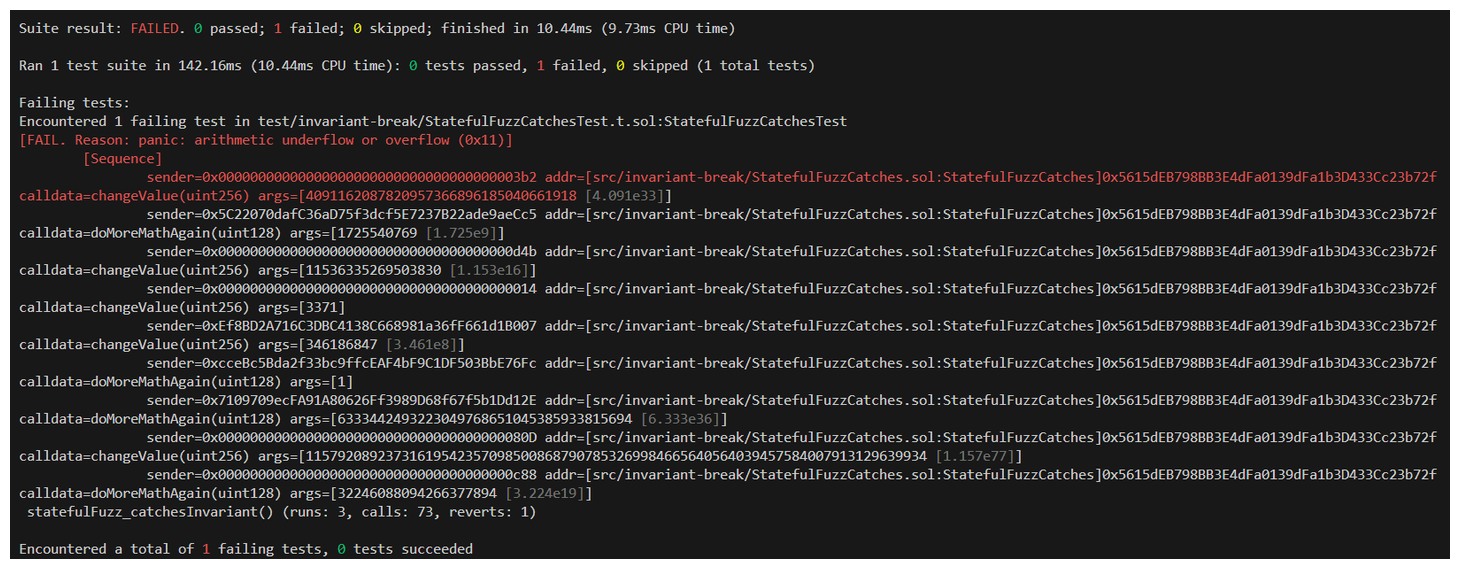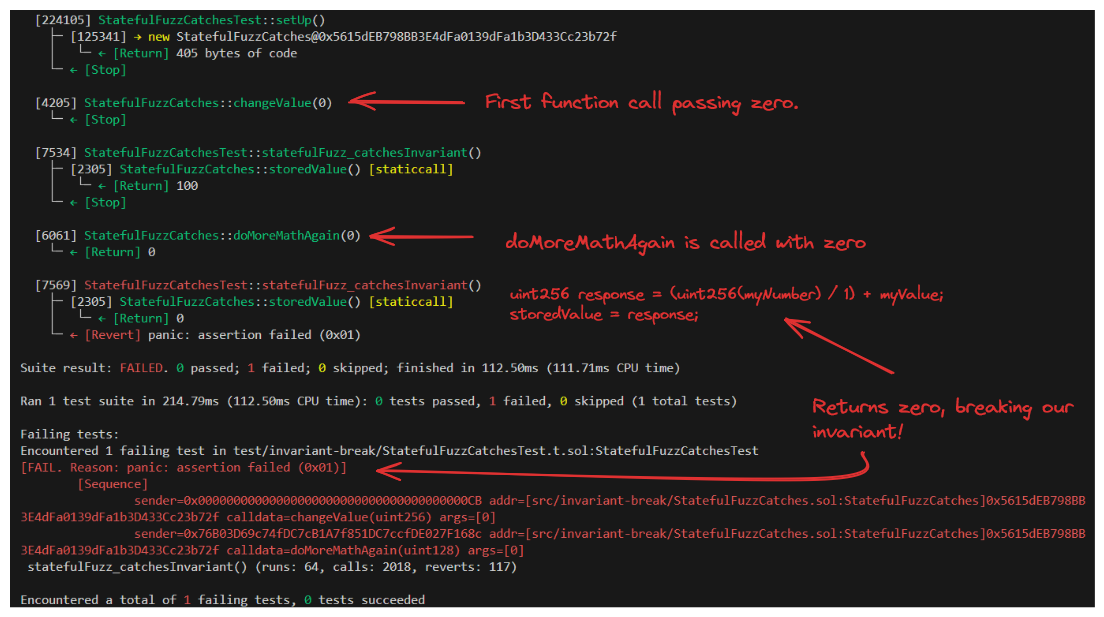--- ### Open Stateful Fuzzing Welcome to Level 2! In this lesson we'll be employing **_stateful_** fuzzing, the defining characteristic of which is that the result of each run is an input for the next run. This methodology will allow us to utilize a fuzz testing approach while considering an ever changing contract state - as would be the case with a deployed protocol, in a live scenario. Let's look at a different contract in our repo now, `StatefulFuzzCatches.sol`. Stateless fuzz catching would have been unable to find vulnerabilities in this situation: ```solidity // SPDX-License-Identifier: MIT pragma solidity 0.8.20; // INVARIANT: doMoreMathAgain should never return 0 contract StatefulFuzzCatches { uint256 public myValue = 1; uint256 public storedValue = 100; /* * @dev Should never return 0 */ function doMoreMathAgain(uint128 myNumber) public returns (uint256) { uint256 response = (uint256(myNumber) / 1) + myValue; storedValue = response; return response; } function changeValue(uint256 newValue) public { myValue = newValue; } } ``` _What makes this contract so difficult for stateless fuzzing?_ Well, let's write a stateless fuzz test for this contract and see what happens, create a file `test/StatefulFuzzCatches.t.sol`... ```solidity // SPDX-License-Identifier: MIT pragma solidity 0.8.20; import {StatefulFuzzCatches} from "src/invariant-break/StatefulFuzzCatches.sol"; import {Test} from "forge-std/Test.sol"; contract StatefulFuzzCatchesTest is Test { StatefulFuzzCatches statefulFuzzCatches; function setUp() public { statefulFuzzCatches = new StatefulFuzzCatches(); } function testDoMoreMathAgain(uint128 data) public { assert(statefulFuzzCatches.doMoreMathAgain(data) != 0); } } ``` A set up just like before, no curveballs. Let's see if it can catch the bug.  No such luck. Even if we ran the test 100,000 times, the bug wouldn't be found. The reason is that the vulnerability within `StatefulFuzzCatches.sol` requires multiple functions to be called in sequence, adjusting the contract state, to be exploited. Let's set up a **stateful** fuzz test now to see how it stacks up. ```solidity // SPDX-License-Identifier: MIT pragma solidity 0.8.20; import {StatefulFuzzCatches} from "src/invariant-break/StatefulFuzzCatches.sol"; import {Test} from "forge-std/Test.sol"; import {StdInvariant} from "forge-std/StdInvariant.sol"; contract StatefulFuzzCatchesTest is StdInvariant, Test { StatefulFuzzCatches statefulFuzzCatches; function setUp() public { statefulFuzzCatches = new StatefulFuzzCatches(); targetContract(address(statefulFuzzCatches)); } function statefulFuzz_catchesInvariant() public view { assert(statefulFuzzCatches.storedValue() != 0); } } ``` In this new **stateful** test, we've imported `StdInvariant` and inherited it. We then need to set the target contract of our fuzz test though `targetContract()`. This tells Foundry which address to call random functions on. Now, the test itself - it's important to note that stateful fuzz tests **must** begin with the key words `statefulFuzz_` or `invariant_`. This is how Foundry determines how to administer the test. Before running this test, I want to look at `foundry.toml` again. You should see a section called `[invariant]`. ```toml [invariant] runs = 64 depth = 32 fail_on_revert = true ``` It's important to understand these few settings we're using here. - runs - how many fuzz tests will be performed with random data - depth - how many random functions will be called per run - fail_on_revert - this value determines if a test will fail as a product of reverted transactions. We'll go into more detail soon. Remember you can always reference the [**Foundry Book**](https://book.getfoundry.sh/reference/config/testing?highlight=%5Binvariant%5D#invariant) for an exhaustive list of these configurations. Let's run the test. ```bash forge test --mt statefulFuzz_catchesInvariant ```  Well, it catches something... but a closer look at the trace output reveals that it's actually reverting due to `arithmetic underflow or overflow (0x11)]`. This is good to know, but it's not actually breaking our invariant. This is where `fail_on_revert` comes into play. If we configure `fail_on_revert` in our `foundry.toml`, to be `false`, this will allow our tests to ignore errors like this and focus on our invariant. Let's try it. ```toml [invariant] runs = 64 depth = 32 fail_on_revert = false ```  In this case our stateful fuzz test works perfectly! The trace indicates that our fuzzer passed `0` to the `changeValue` function, and then subsequently passed `0` to `doMoreMathAgain` resulting in a return of `0`, breaking our invariant!
Open Stateful Fuzzing
Welcome to Level 2! In this lesson we'll be employing stateful fuzzing, the defining characteristic of which is that the result of each run is an input for the next run.
This methodology will allow us to utilize a fuzz testing approach while considering an ever changing contract state - as would be the case with a deployed protocol, in a live scenario.
Let's look at a different contract in our repo now, StatefulFuzzCatches.sol. Stateless fuzz catching would have been unable to find vulnerabilities in this situation:
What makes this contract so difficult for stateless fuzzing?
Well, let's write a stateless fuzz test for this contract and see what happens, create a file test/StatefulFuzzCatches.t.sol...
A set up just like before, no curveballs. Let's see if it can catch the bug.

No such luck.
Even if we ran the test 100,000 times, the bug wouldn't be found. The reason is that the vulnerability within StatefulFuzzCatches.sol requires multiple functions to be called in sequence, adjusting the contract state, to be exploited.
Let's set up a stateful fuzz test now to see how it stacks up.
In this new stateful test, we've imported StdInvariant and inherited it. We then need to set the target contract of our fuzz test though targetContract(). This tells Foundry which address to call random functions on.
Now, the test itself - it's important to note that stateful fuzz tests must begin with the key words statefulFuzz_ or invariant_. This is how Foundry determines how to administer the test.
Before running this test, I want to look at foundry.toml again. You should see a section called [invariant].
It's important to understand these few settings we're using here.
runs - how many fuzz tests will be performed with random data
depth - how many random functions will be called per run
fail_on_revert - this value determines if a test will fail as a product of reverted transactions. We'll go into more detail soon.
Remember you can always reference the Foundry Book for an exhaustive list of these configurations.
Let's run the test.

Well, it catches something... but a closer look at the trace output reveals that it's actually reverting due to arithmetic underflow or overflow (0x11)]. This is good to know, but it's not actually breaking our invariant. This is where fail_on_revert comes into play.
If we configure fail_on_revert in our foundry.toml, to be false, this will allow our tests to ignore errors like this and focus on our invariant. Let's try it.

In this case our stateful fuzz test works perfectly! The trace indicates that our fuzzer passed 0 to the changeValue function, and then subsequently passed 0 to doMoreMathAgain resulting in a return of 0, breaking our invariant!
Where Stateless Fuzzing Fails
Patrick walks through some testing failures and how Foundry can be configured to achieve better results.
Previous lesson
Previous
Next lesson
Next
Duration: 25min
Duration: 1h 18min
Duration: 35min
Duration: 2h 28min
Duration: 5h 03min
Duration: 5h 22min
Duration: 4h 33min
Duration: 2h 01min
Duration: 1h 40min